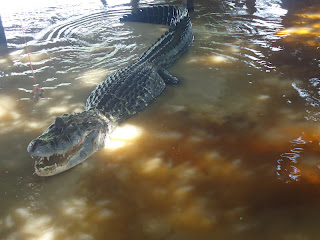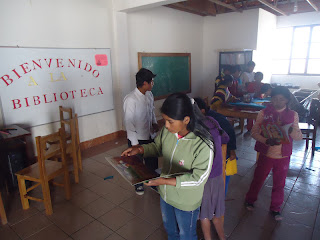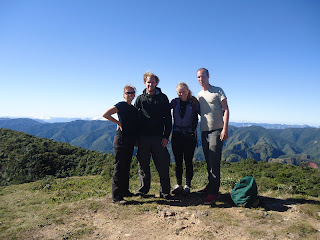Disclosure: I wrote this the day I returned to America and took five weeks to post it. So when I refer to last week, it actually means a month and a half ago. My bad.
Well, I have touched back down in the states. My time in Bolivia is over. When I said my goodbyes at BiblioWorks I actually started to cry– I guess that goes to show how much I enjoyed my time in Bolivia working for BiblioWorks.
 |
| Maritza and Matt– they work so hard to make BiblioWorks function |
 |
| The office had a little going away party for me, so sweet! The cake had a candle and everything. |
The past two months were the fastest of my life. As I write this I literally cannot believe that it is over. I can clearly remember when I left for Bolivia, and to be honest I wasn't 100% ready to leave home after just getting back from the Philippines. I remember when I left America I thought, okay two months isn't that long, it will fly by. And that it did! Maybe it was a mistake leaving the U.S for Bolivia so shortly after my arrival from Southeast Asia. I mean, it was good that I left so quickly because it meant I avoided, well postponed, my culture shock. Since I was only home for a mere three weeks I felt like I was on vacation and therefore didn't face many of the problems, depression, and dissatisfaction that many people who study or live in a developing country feel upon returning to the U.S. But, on the flip side, I think my first two weeks I wasn't fully committed to Bolivia. My mind was on the Philippines, the fun events happening at Bowdoin, and how much I had cherished the time I spent back home visiting my friends and family. I thought it would be an easy transition– Southeast Asia to South America, but it wasn't. I think all the factors i listed above made my initial experience in Bolivia very different than what I had expected. Don't interpret this the wrong way and think I didn't enjoy Bolivia– the moment I arrived I knew that I was in an incredible country and I liked what I was doing, but it took time for me to realize that I love Bolivia. Overtime I became more and more passionate about the country and my role at BiblioWorks. When people asked me if I liked Bolivia I always said yes, but now I say, no I don't like it– I love it!
By far the biggest contributor to my increased enthusiasm was my work at Pampa Aceituno. The first month was frustrating with the number of strikes, holidays, and also I lacked the courage to go to Pampa Aceituno by myself. Lize only goes on Tuesday and Thursdays, so I only felt comfortable going on Tuesday and Thursdays. It's funny, I have absolutely no problem traveling or living by myself– I can be completely independent but when it came to working at Pampa Aceituno I was hesitant. Why? Because from the get-go I had been there with Lize, I had never had to venture on my own. I became accustomed to this, and going by myself seemed like it wouldn't be normal, I would be changing the system and pushing my comfort zone. I was nervous to be there by myself, what if I couldn't communicate my thoughts or understand. Lize doesn't speak English but if I didn't understand something I could later turn to her and ask her to explain it more slowly. I finally had that push I needed from Matt to go to Pampa Aceituno by myself. And of course, once I was on my way, there was absolutely no problem. If only I had gone into the library by myself the second week I was here, I would have realize that really it was all in my head. Additionally, after the first month there were fewer strikes and holidays as well.
The past three weeks in Sucre I have been so busy! Last week I completed two grants for BiblioWorks. One was for a library in a completely new community and the other a proposal for a BiblioBus with a focus on health and wellness. On top of that I've been preparing for all my activities in Pampa Aceituno, visiting the library every other day, and upping my hours in Spanish class. I felt as though there weren't enough hours in the day! All of the sudden I was down to days left in Sucre and all I could think about was how in my first two weeks in Bolivia I didn't capitalize on all my opportunities and my situation. I would love to have 2 more weeks in Sucre!! Why can't I take those first two weeks and move them to the end? :)
 |
| One of my last days in Pampa Aceituno |
My time in BiblioWorks, Pampa Aceituno, and Sucre has been unforgettable and has really got me thinking what I want to do once I graduate– The Peace Corps is now heavily on my mind, finding a permanent position at an organization like BiblioWorks, going to grad school for policy work so I can be more educated in how to make a difference, or maybe just teaching English as a second language.
Bolivia is frequently misunderstood and misrepresented by neighboring countries. Because its poverty and developing state, larger and more developed nations like Chile, Argentina, Brazil, and even Peru refer to Bolivia as poor, dangerous and an unfriendly place to visit. I've met only kind people, have found myself in no dangerous situations, and yes, it is an impveorshed country but that in no way makes it a bad place. Bolivia is absolutely beautiful in every meaning of the word. I am so grateful to Bowdoin and the McKeen Center for giving me this opportunity to volunteer in such an inspiring organization with an important mission, and of course in an incredibly country. Entonces, hasta luego Bolivia. Voy a volver.




































